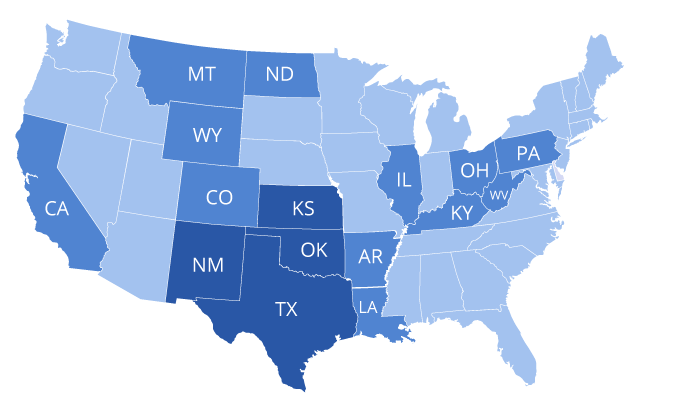Oil & Gas
Mineral Management
the value of your oil and gas mineral rights.
Sell Your Mineral Rights (Request an Offer):
First Things First
Know What You Own
The first rule of mineral management is to know what you own. Knowing what you own puts you at a distinct advantage and will help you maximize your mineral rights value.
Let’s review the:

Maximize Your Minerals
Advantages of Mineral Management
Mineral owners who know what they own and actively manage their minerals are savvier and often:
- Know when new wells are permitted
Catch underpayments and royalty errors quickly - Know the going lease and royalty rates in the area
- Connected with other royalty owners
- Able to leave well-organized and managed minerals to their heirs
- Ready and able to teach the next generation how to manage mineral rights
- Know if they are not receiving royalties for a well on a tract of land in which they own interest
- More likely to negotiate favorable lease terms
What is Important?
Documents to Keep
There are a lot of ways to manage your records. At a minimum, you should keep original documents in file folders and digital copies similarly organized in the cloud. We recommend keeping both digital and paper records of title documents, oil and gas leases, division orders, and royalty statements.
Title Documents
Deeds, probate records and affidavits of heirship trace the title of the minerals from your ancestors to you and determine the number of net and gross acres owned.
Oil & Gas Leases
Current and previous oil and gas leases include the legal description, royalty rate, and lease terms. Non-producing minerals may not have a lease.
Division Orders
Royalty Statements
Physical & Digital Files
Organizing Your Mineral Records
Choose the filing method that meets your needs. If you have multiple tracts of land in the same county, it may make sense to organize them by legal description with dividers by state and county.
For example, you might have a divider for Texas and sub-divider for Ward County. Inside, there may be hanging folders labeled with the section, block, and abstract numbers.
Counties that follow the Public Land Survey System can be organized by section, range, and township.
Each folder will hold the title documents, leases, division orders, well documents, and a sample royalty check.
Keeping Digital Records
To keep things simple, create the same digital file on Google Drive, iCloud, or another cloud-based storage service. Inside each folder, create sub-folders for the different types of documents. It’s also good to store maps of the basin, field, and the location of your minerals.
Try overlaying maps to see if your mineral rights are in an active drilling area.

Know What You Own
Mineral Management Spreadsheet
Once you have your documents, you can create a mineral management spreadsheet, which makes it easier to find the information you are looking for quickly.
We have created a free Mineral Management Spreadsheet that you can download and modify to suit your needs. The spreadsheet has been updated for 2025, to match our mineral management system more closely.
The basic spreadsheet has tabs for tracking overall ownership (legal descriptions), wells, revenue, 1099s, and property taxes.
You might be amazed by what you learn while going through this process.
Need some help? The regulars on the Mineral Rights Forum are a friendly and knowledgeable bunch.
Reading a few mineral management books and reviewing oil and gas terminology can also be helpful.
Want to maximize your mineral rights? Invest in your own education! You are your best advocate so taking the time to learn about your mineral rights will benefit you and future generations.
Checking Against Public Sources
Monthly Production & Income Verification
Each oil and gas royalty statement should be carefully examined to verify the following:
- Decimal interest (should match your division order)
- Production volumes (should match what was reported to your state’s oil and gas regulatory agency)
- Deductions (cost-free leases should remain cost-free, all others should only include allowed deductions)
- Income (Gross values multiplied by your decimal interest should match net values)
Royalty check errors most often occur when operators change or the operator updates their software. As a rule of thumb, it’s good to verify every single royalty check. If you suspect a serious problem, there are specialty firms that can perform comprehensive royalty audits.
Confused by your royalty statement? Learn how to read an oil & gas royalty statement.

Get and Stay Organized
Mineral Management Software
Mineral owners who manage multiple wells across many tracts of land may find it easier and more effective to utilize a mineral management software solution.
There are several mineral management software packages, most of which are cloud-based and accessible from the web browser. A demo with each company will help you compare features and choose the right solution for your situation.
Keep in mind the following:
Documents
Some mineral owners prefer to keep their documents stored inside a mineral management system, where each document can be associated with a specific tract of land or lease. Just make sure the software you choose has a way to export your data in the future.
Tracts & Leases
Mineral management software can help you visualize the tracts of land and leases lines in which you own an interest. This allows you to see which wells lie inside your lease or property lines, making it easier to make sure you are in pay status for well. Most software has the ability to alert you when you are not being paid on an oil or gas that resides within a specific tract of land or lease.
Income
Mineral management software can also help verify the accuracy of royalty payments. Some programs automatically import royalty data from EnergyLink or Oildex while allowing you to import or manually enter checks from smaller operators. Most mineral management software solutions have advanced reporting that would be difficult for you to replicate without their software.
Each month, you should verify decimal interest, production volume, and deductions on each royalty check. Manually auditing checks can be a tedious process, and it is easy to overlook small anomalies, new deductions, or when you fall out of pay status. Mineral management software can automate this process and save you money by catching small problems as they occur.
Reconnaissance
Mineral Management software can also help you keep track of new activity on your property as well as any offset activity nearby. You can usually set up an alert so that you are automatically notified when a new well is permitted within a specific radius of your property. Knowing about the nearby drilling activity can help you negotiate better lease terms, and allow you to follow up on any outstanding division orders.


Outsourcing Labor
Mineral Management Services
Managing a large portfolio of mineral rights can be time-intensive and requires extensive knowledge (especially if the minerals span multiple states).
Some mineral owners prefer to outsource the management of their mineral rights.
Mineral management firms take care of:
- Production and income verification
- Executing division orders
- Oil and gas lease negotiation
- Lease and offset activity monitoring
- Reporting
Mineral management firms often employ land professionals, certified mineral managers, division order specialists, accountants, and even legal professionals. Some companies have their own proprietary mineral management software, while others use one or more of the top mineral management software solutions.
We buy mineral rights but we do not provide management services. However, we’ll be happy to refer you to a reputable firm.
Nationally Focused
Where We Buy Mineral Rights
We buy both producing and non-producing minerals in all oil and gas states. However, we are especially interested in Texas and Kansas mineral rights.
|
We even buy minerals in more obscure states, which produce very little oil and gas compared to other states.

Valuation Factors
How We Value Mineral Rights
There are many factors that play into the value of mineral rights. These include location, producing vs. non-producing properties, current oil and gas prices, well production figures, lease terms, and even the operator of the well or wells. We also look at the risks of buying and owning minerals that you are interested in selling.
Location
Minerals in the hottest shale plays are more valuable than those in older fields with conventional wells.
Producing vs. Non-Producing
Producing minerals are often worth more than non-producing minerals because they are generating revenue.
Oil & Gas Prices
When oil and gas prices drop, revenue drops, and sometimes operators are unable to continue operating the well.
Production
Highly productive wells (and off-set wells) can increase the value of your minerals.
Lease Terms
Favorable lease terms (such as a 25% royalty reservation) positively impact the value of the leased minerals.
Operator
A small number of operators are unethical, and their reputation automatically devalues your minerals.
Why Sell?
Why People Sell Their Mineral Rights
I am putting my affairs in order. I don’t want to burden my kids with the hassle of transferring ownership and managing small mineral rights. When my sister passed away, my niece and nephew had to hire an attorney to help them with the minerals. I don’t want my kids to go through that.
I inherited my mineral rights so they were sentimental, but I don’t really want to bother with managing them and filing extra tax returns. I decided to sell and use the money as a down payment on my house.
I had no idea how fast the oil production would decline. My checks are only 20% of what they were a few years ago. I should have sold my mineral rights when the wells were brand new and still generating huge royalties.
My oil wells have been producing for decades and the reserves are almost depleted. Once the wells are plugged, the value will be significantly lower. I’d rather cash out now.
I inherited mineral rights, but don’t want to be involved with fracking and fossil fuels. I would prefer to support renewable energy and do my part to reverse climate change.
